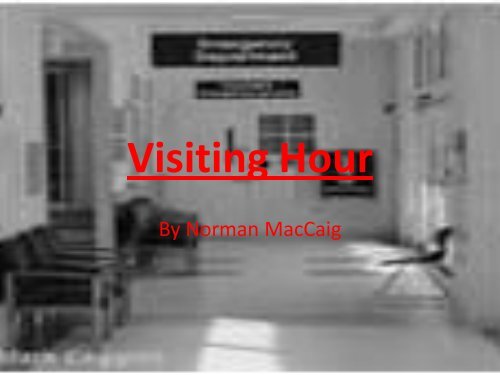Visiting_Hour_stanza1-5
Visiting_Hour_stanza1-5
Visiting_Hour_stanza1-5
- No tags were found...
Create successful ePaper yourself
Turn your PDF publications into a flip-book with our unique Google optimized e-Paper software.
<strong>Visiting</strong> <strong>Hour</strong>By Norman MacCaig
Themes• Facing Death (either the dying person, or therelative)• Isolation surrounding death/emotion
Structure•The way a text is puttogether and thedevelopment of ideas ina text
Structure of the poem• Free verse is used throughout, which reflectsthe poet’s confusion and suits the narrativestyle of the text (there is an introduction tothe character and setting, followed bydevelopment, climax, and an epilogue).
• The verses deal with the poet’s progressionthrough the visit, from his entering thehospital and making his way to the ward, upto him leaving after the visit.• Each verse reveals more of the poet’semotions.
• The poem is written in a narrative structure.– We are given an introduction, setting andcharacter– We are then given further detail anddevelopment– Then the poem reaches a climax– Finally, we are given a sort of conclusion.
More on StructureThe structure of a MacCaig poem will tend to:• have a startling opening (often humorous)• set up a contrast (often starting with thenegative side first)• have a central point in the middle• end with an opposite, or different, point ofview
Remember!• It is important to note the stanzas arestructured in free verse and this almost as ifwe go on the journey with the speaker- weshare his experience
Stream of Consciousness• The poem is written in a stream ofconsciousness style. This means we are giventhe written equivalent of the character’sthought processes as he isthinking them.
Tone• The expression of the writer’s feelings orattitude to his subject• Starts off with a strong element of nervoushumour and progresses to sadness anddespair
Stanza 1• Summary - The poet encounters the hospitalsmell and attempts to take his mind off what itmeans to him.
Introduction• The first line of the poem is effective ingrabbing the reader’s attention, by referringto a very vivid and distinctive sensory image;“The hospital smell” which the reader canassociate with.
What is word-choice?• The writer creates a mental picture for thereader by using words that are specific andaccurate.• The writer uses strong action verbs wheneverpossible to show the reader what is happeningrather than tell the reader.
• “combs my nostrils” – Word choice is used togive a sense of the pervasive power of thesmell, and his feeling of being invaded;showing his discomfort.
Synecdoche• This is a figure of speech in which a part ofsomething is used to refer to the whole of it.eg. “The hired hands are not doing their jobproperly”• Or Cat referring to a lion
• “bobbing along” – Synecdocheis used, since not just his nostrils are movingalong, as the image would suggest. Thisemphasises the overpowering nature of “thehospital smell”, since it has blocked out his othersenses.
• “green and yellow corridors” – word- choicecolours have connotations of sickness, urineand puss which further stresses the poet’sdiscomfort in these surroundings.
Stanza 2• Summary- However, he is immediatelyconfronted by what hospitals are potentiallyabout – death.
Enjambment• A line of verse that flows on to the next linewithout a pause.• “What seems a corpse/ is trundled into a liftand vanishes/ heavenward” – Enjambment isused here to emphasise the last words of thelines, carefully chosen to suggest a finality indeath;
• “corpse” - word-choice – holds little relationto life, suggesting the finality of death. Theharshness of the sound; with a guttural “c”and plosive “p”, shows the poet’s distress andthe painful emotions he is facing.
Imagery• A combined term for figurativelanguage in the form of a simile,metaphor or personification
• “vanishes” further stresses the poet’s viewthat death is absolute.• “heavenward” seems strange, - this is simplyan example of MacCaig trying to avoid theseriousness of the visit by creating unusualimages – imagery
Stanza 3• Summary - He forces himself to keep hisemotions under control.
• “I will not feel, I will not/feel, until/ I haveto.” – Repetition and enjambment is used tosuggest the poet is chanting under his breathin order to avoid his emotions. He trying toremain in control.
Stanza 4• Summary- He tries to occupy his mind bywatching the nurses. But this, too, only turnshis mind to what their job involves – sufferingand death.
Syntax• The way in which sentences are constructed“here and up and down and there” – theunusual syntax (word order) is the poet tryingto lighten the mood, while also emphasisingthe number of nurses he sees and theiractions. It suggests MacCaig is looking allaround to find a distraction from his thoughtsThe unusual syntax on this line causes us topause and consider its meaning.
• “miraculously” – word- choice suggestsMacCaig’s admiration for the nurses’ abilities,while showing his own worry about the wayhe will cope with the emotions.
• “so much pain, so/ many deaths …/ so manyfarewells” – Repetition of “so” stresses thefrequency of the nurses’ unpleasant dealings,which supports the high esteem, perhapsenvy, with which he regards the ability of thenurses to cope.
• “farewells” – the ending of the verse on thisdraws attention to the word, which underlinesthe purpose of his visit.
Stanza 5• Summary- He arrives at the ward where hiswife lies. He is shocked by what he sees – in awhite environment, doped up with morphineand on a drip. He has difficulty making this fitwith the woman he knows.
“Ward 7.” – caesura is a pause that breaks up aline of verse.– The abruptness of this non sentence jolts thereader, just as we can imagine it affectedMacCaig. This is the turning point of thepoem, as he has now reached his relative andmust face his emotions.
References to structure• “What seems a corpse/ is trundled into a liftand vanishes/ heavenward” – Enjambment• “I will not feel, I will not/ feel, until/ I haveto.” – Repetition• “here and up and down and there” – theunusual syntax (word order)• “so much pain, so/ many deaths …/ so manyfarewells” – Repetition


